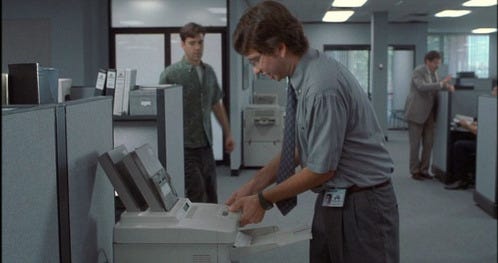Monolithic insanity, or Are we reinventing the office yet?
My first office job was a co-op/internship filled with classic drab cubicles. My cubicle was one stall over from the printer but the partition between my desk and the neighbouring cubicle was inexplicably missing. This was 1995 which means a) Office Space was still four years away so I’d yet to see my job parodied on screen, b) printers were slow and c) people printed a lot of stuff. While they waited for their pages to lazily emerge from the printer, my side profile was one of the few things in their line of sight.
I felt exposed all the time and I hated it, but it was my first real programming job and I was NOT going to complain.
I’m not sure where we draw the line between cubicle seas and open plan offices. In that early job, one side of the cubicle was tall while the others were low enough to yield no visual privacy, but compared to the open offices I would encounter later, it was actually not that bad. Unfortunately, I can only appreciate that in hindsight.
“Open plan is the generic term used in architectural and interior design for any floor plan that makes use of large, open spaces and minimizes the use of small, enclosed rooms such as private offices.” - Wikipedia
A lot of pixels have been dedicated to the history of office layouts and I won’t rehash it here. (Carry on to the end for an appendix of good resources if you’re interested.) The TL;DR is this: a few visionaries have shown us glimpses of what offices could be, only to see the inspiration stripped away in the implementation, leaving us with a glut of workspaces that maximize workers-per-square-foot without creating the conditions for stronger communication, better collaboration, or extended deep work.
Open offices 👎
Open bullpens and low-walled cubicles are not my favourite places. They are terrible for getting productive deep work done. The conversations and constant movement in the periphery knock me out of flow. At the same time, there’s social pressure to not talk lest you disrupt others, leading to knowledge workers sitting in the same large space donning noise-cancelling headphones and communicating over Slack/email/Teams/etc., negating the purported collaboration benefit.
In fact, a study of two Fortune 500 companies that moved from cubicles to open office found “face-to-face interactions dropped by roughly 70% after the firms transitioned to open offices, while electronic interactions increased to compensate.”
Open office layouts are not without virtue, depending on the type of work you’re doing. While they can cruelly situate noisy phone talkers next to quiet deep workers, they also provide an environment conducive to low-friction, high-bandwidth conversation that is hard to replicate in a remote world.
Reinventing our offices
As I’ve talked to people wrestling with permanent hybrid arrangements and return-to-office mandates, I’ve come to believe we need to seize the opportunity to innovate in ways that let us capture the value of in-person time without losing all the productivity and lifestyle benefits of working from home.
Obviously, there is no one-size-fits-all solution. It depends on the team, the type of work they do, their commuting situations, and their home arrangements. I believe that’s part of the opportunity - use the newfound flexibility of underused office space and hybrid work to empower teams to adapt physical spaces to best achieve their outcomes, taking into account the specific needs of the team.
For software development, I like:
clusters of four to six people in a common space,
whiteboards,
desks arranged to allow discussion and prevent others from spying on your screen (or being in the background of your video calls), and
nearby private space for calls and small meetings (preferably dedicated to the team).
It would be easy enough to arrange for two teams to share the same space on a rotating schedule, addressing a common complaint with hybrid work that expensive office space is underutilized.
I’ve described a layout that I like and if you’re thinking it sounds awful or ill-suited to your team, great! My entire point is that we should embrace adaptation rather than uniformity. Robert Propst tried to give us that in the 1960s when he designed the Action Office for Herman Miller:
In 1997, Robert Propst said that he had hoped that his idea would "give knowledge workers a more flexible, fluid environment than the rat-maze boxes of offices," but regretted that his idea had evolved to some extent into just that, saying that "the cubicle-izing of people in modern corporations is monolithic insanity." - Wikipedia
If you find yourself in a hybrid arrangement with underused offices, I challenge you to be brave and experiment. With some intentionality, empathy, and creativity, you just might be able to discover some of the flexibility and fluidity that Propst wanted us to have.
- Derek
P.S. If you’ve found something that works, please don’t keep it to yourself! Share a comment on LinkedIn or send me an email if you don’t want to post publicly.
The Promised Appendix
Redesigning How We Work (HBR)
This Is Why So Many Companies Insist on Open Offices Now (The Muse)
Action Office (Wikipedia)
Workplace Woes: The ‘Open’ Office Is a Hotbed of Stress (Time)
Office Space Time Loop: From Open Plans to Cubicle Farms and Back Again (99% Invisible)
Yes, the Open Office Is Terrible — But It Doesn’t Have to Be (Freakonomics podcast)
Open offices are overrated (Vox on YouTube)


